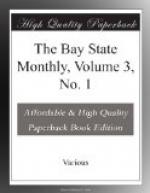From the day that treaty was ratified to the present, it has been a fertile source of discord and misunderstanding between the two governments; and from 1850 to 1858 its provisions were thrice made the basis of a proposal to arbitrate as to their meaning: their modification and abrogation have been alike contingently considered, and their imperfect and vexatious character have been repeatedly recognized on both sides. Even the present administration is laboring with the difficulty, and seeking some honorable way to free the treaty from its embarrassing features, or entirely abrogate it. President Buchanan, in 1858, characterized and denounced the treaty as “one which had been fraught with misunderstanding and mischief from the beginning;” and the leading statesmen of the country have felt that it was entirely inadequate to reconcile the opposite views of Great Britain and the United States towards Central America.
The Honorable James G. Blaine, late Secretary of State under the lamented Garfield, in his diplomatic correspondence with Lord Granville, in 1881, in summing up his review of the negotiations concerning this treaty, says: “It was frankly admitted on both sides that the engagements of the treaty were misunderstandingly entered into, improperly comprehended, contradictorily interpreted, and mutually vexatious.”
An examination of the diplomatic correspondence and the Congressional Records of the years 1852-3-4 reveals what may perhaps be unknown history to many of my readers; that Great Britain within one year after she signed and ratified the Clayton-Bulwer Treaty, and agreed therein NOT “to colonize, fortify, or exercise control over, any part of Central America,” did seize upon, colonize and partially fortify and exercise control over the five islands in the Bay of Honduras, called the Bay Islands; and that she did this in derogation of the declarations of the “Monroe Doctrine,” and in direct violation and contempt of the Treaty, which she had so recently entered into; that this same national cormorant immediately surveyed and made a new geographical plan of Central America, in which she extended her province of Balize from the river Hondo, on the north, to the river Sarstoon on the south, and from the coast of the bay westward to the falls of Garbutts on the river Balize; or five times its original size; and then modestly claimed that her possessions were not in Central America, and therefore not within the provisions of the Clayton-Bulwer Treaty; that she has to this day continued her protectorate, as she calls it, of the Mosquito Coast, and that within six days after the Treaty of California, which secured to us that “pearl of the occident,” she seized San Juan and occasioned a brief naval excitement at Greytown, the port of the San Juan river. This last kick by Great Britain at the treaty she had so solemnly promised to abide by was the most barefaced and impudent of all; for it was at that time supposed by every body who had considered the question of an inter-oceanic canal, that if built at all it would be by way of the San Juan river, Lake Nicaragua, and across Nicaragua to the Pacific; thus making Greytown the important port of said canal, and the key to the control of the entire commerce thereon.




